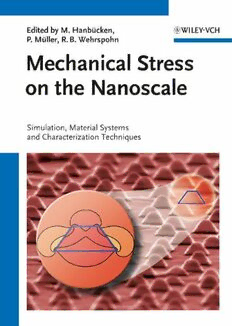Table Of ContentEdited by
Margrit Hanbu¨cken,
Pierre Mu¨ller,
and Ralf B. Wehrspohn
Mechanical Stress
on the Nanoscale
Related Titles
Alkauskas, A.,Deák, P., Neugebauer,J., Zehetbauer,M. J.,Zhu, Y.T.(eds.)
Pasquarello,A.,VandeWalle,C.G.(eds.)
Bulk Nanostructured Materials
Advanced Calculations
736pageswith366figuresand31tables
for Defects in Materials
2009
ElectronicStructureMethods Hardcover
ISBN:978-3-527-31524-6
402pageswith118figures
2011
Cazacu, O.(ed.)
Hardcover
ISBN:978-3-527-41024-8 Multiscale Modeling of
Heterogenous Materials
Jackson, K. A.
FromMicrostructuretoMacro-Scale
Kinetic Processes Properties
CrystalGrowth,Diffusion,and 343pages
PhaseTransitionsinMaterials 2008
453pageswith291figures Hardcover
2010 ISBN:978-1-84821-047-9
Hardcover
ISBN:978-3-527-32736-2 Birkholz, M.
Thin Film Analysis by
Stallinga,P.
X-Ray Scattering
Electrical Characterization
SharingthePlanet’sFreshwater
of Organic Electronic Resources
Materials and Devices 378pageswith175figuresand28tables
2006
316pages
Hardcover
2009
Hardcover ISBN:978-3-527-31052-4
ISBN:978-0-470-75009-4
Edited by
Margrit Hanbücken, Pierre Müller, and Ralf B. Wehrspohn
Mechanical Stress on the Nanoscale
Simulation, Material Systems and Characterization
Techniques
TheEditors AllbookspublishedbyWiley-VCHarecarefully
produced.Nevertheless,authors,editors,and
Dr.MargritHanbücken publisherdonotwarranttheinformationcontained
CINaM-CNRS inthesebooks,includingthisbook,tobefreeof
CampusLuminy errors.Readersareadvisedtokeepinmindthat
Marseille,Frankreich statements,data,illustrations,proceduraldetailsor
otheritemsmayinadvertentlybeinaccurate.
Dr.PierreMüller
LibraryofCongressCardNo.: appliedfor
UniversitéPaulCézanne
CampusSaint-Jérôme
BritishLibraryCataloguing-in-PublicationData
Marseille,Frankreich
Acataloguerecordforthisbookisavailablefromthe
BritishLibrary.
Prof.Dr.RalfB.Wehrspohn
FraunhoferInst.für Bibliographicinformationpublishedby
WerkstoffmechanikHalle theDeutscheNationalbibliothek
Halle,Germany TheDeutscheNationalbibliothekliststhispublica-
tionintheDeutscheNationalbibliografie;detailed
bibliographicdataareavailableontheInternetat
http://dnb.d-nb.de.
#2011Wiley-VCHVerlag&Co.KGaA,
Boschstr.12,69469Weinheim,Germany
Allrightsreserved(includingthoseoftranslation
intootherlanguages).Nopartofthisbookmaybe
reproducedinanyform–byphotoprinting,
microfilm,oranyothermeans–nortransmittedor
translatedintoamachinelanguagewithoutwritten
permissionfromthepublishers.Registerednames,
trademarks,etc.usedinthisbook,evenwhennot
specificallymarkedassuch,arenottobeconsidered
unprotectedbylaw.
Typesetting ThomsonDigital,Noida,India
Printing
Binding
CoverDesign Grafik-DesignSchulz,Fußgönheim
PrintedinSingapore
Printedonacid-freepaper
PrintISBN: 978-3-527-41066-8
ePDFISBN:978-3-527-63956-4
oBookISBN: 978-3-527-63954-0
ePubISBN: 978-3-527-63955-7
V
Contents
Preface XV
List of Contributors XVII
PartOne FundamentalsofStressandStrainontheNanoscale 1
1 ElasticStrainRelaxation:ThermodynamicsandKinetics 3
FrankGlas
1.1 BasicsofElasticStrainRelaxation 3
1.1.1 Introduction 3
1.1.2 PrinciplesofCalculation 4
1.1.3 MethodsofCalculation:ABriefOverview 6
1.2 ElasticStrainRelaxationinInhomogeneousSubstitutionalAlloys 7
1.2.1 SpinodalDecompositionwithNoElasticEffects 8
1.2.2 ElasticStrainRelaxationinanAlloywithModulatedComposition 9
1.2.3 StrainStabilizationandtheEffectofElasticAnisotropy 11
1.2.4 ElasticRelaxationinthePresenceofaFreeSurface 11
1.3 Diffusion 12
1.3.1 DiffusionwithoutElasticEffects 12
1.3.2 DiffusionunderStressinanAlloy 13
1.4 StrainRelaxationinHomogeneousMismatchedEpitaxialLayers 14
1.4.1 Introduction 14
1.4.2 ElasticStrainRelaxation 15
1.4.3 CriticalThickness 16
1.5 MorphologicalRelaxationofaSolidunderNonhydrostaticStress 17
1.5.1 Introduction 17
1.5.2 CalculationoftheElasticRelaxationFields 18
1.5.3 ATGInstability 19
1.5.4 KineticsoftheATGInstability 21
1.5.5 CouplingbetweentheMorphologicalandCompositional
Instabilities 21
1.6 ElasticRelaxationof0Dand1DEpitaxialNanostructures 22
1.6.1 QuantumDots 23
VI Contents
1.6.2 Nanowires 24
References 24
2 FundamentalsofStressandStrainattheNanoscaleLevel:
TowardNanoelasticity 27
PierreMüller
2.1 Introduction 27
2.2 TheoreticalBackground 28
2.2.1 BulkElasticity:ARecall 28
2.2.1.1 StressandStrainDefinition 29
2.2.1.2 EquilibriumState 29
2.2.1.3 ElasticEnergy 30
2.2.1.4 ElasticConstants 30
2.2.2 HowtoDescribeSurfacesorInterfaces? 31
2.2.3 SurfacesandInterfacesDescribedfromExcessQuantities 34
2.2.3.1 TheSurfaceElasticEnergyasanExcessoftheBulk
ElasticEnergy 34
2.2.3.2 TheSurfaceStressandSurfaceStrainConcepts 35
2.2.3.3 SurfaceElasticConstants 37
2.2.3.4 ConnectingSurfaceandBulkStresses 39
2.2.3.5 SurfaceStressandSurfaceTension 40
2.2.3.6 SurfaceStressandAdsorption 41
2.2.3.7 TheCaseofGlissileInterfaces 42
2.2.4 SurfacesandInterfacesDescribedasaForeignMaterial 42
2.2.4.1 TheSurfaceasaThinBulk-LikeFilm 43
2.2.4.2 TheSurfaceasanElasticMembrane 43
2.3 Applications:SizeEffectsDuetotheSurfaces 44
2.3.1 LatticeContractionofNanoparticles 44
2.3.2 EffectiveModulusofThinFreestandingPlaneFilms 46
2.3.3 Bending,Buckling,andFreeVibrationsofThinFilms 48
2.3.3.1 GeneralEquations 48
2.3.3.2 Discussion 50
2.3.4 StaticBendingofNanowires:AnAnalysisoftheRecent
Literature 52
2.3.4.1 YoungModulusversusSize:Two-PhaseModel 52
2.3.4.2 YoungModulusversusSize:SurfaceStressModel 53
2.3.4.3 PrestressBulkDuetoSurfaceStresses 53
2.3.5 AShortOverviewofExperimentalDifficulties 54
2.4 Conclusion 55
References 56
3 OnsetofPlasticityinCrystallineNanomaterials 61
LaurentPizzagalli,SandrineBrochard,andJulienGodet
3.1 Introduction 61
3.2 TheRoleofDislocations 63
Contents VII
3.3 DrivingForcesforDislocations 63
3.3.1 Stress 64
3.3.2 ThermalActivation 64
3.3.3 CombinationofStressandThermal
Activation 64
3.4 DislocationandSurfaces:BasicConcepts 65
3.4.1 ForcesRelatedtoSurface 65
3.4.2 BalanceofForcesforNucleation 66
3.4.3 ForcesDuetoLatticeFriction 66
3.4.4 SurfaceModificationsDuetoDislocations 68
3.5 ElasticModeling 68
3.5.1 ElasticModel 68
3.5.2 PredictedActivationParameters 70
3.5.3 WhatisMissing? 70
3.5.4 Peierls–NabarroApproaches 72
3.6 AtomisticModeling 72
3.6.1 ExamplesofSimulations 73
3.6.2 DeterminationofActivationParameters 74
3.6.3 ComparisonwithExperiments 75
3.6.4 InfluenceofSurfaceStructure,Orientation,and
Chemistry 76
3.7 ExtensiontoDifferentGeometries 78
3.8 Discussion 79
References 80
4 RelaxationsontheNanoscale:AnAtomistic
ViewbyNumericalSimulations 83
ChristineMottet
4.1 Introduction 84
4.2 TheoreticalModelsandNumericalSimulations 85
4.2.1 EnergeticModels 85
4.2.2 NumericalSimulations 87
4.2.3 DefinitionsofPhysicalQuantities 89
4.3 RelaxationsinSurfacesandInterfaces 91
4.3.1 SurfaceReconstructions 92
4.3.2 SurfaceAlloys:aSimpleCaseofHeteroatomic
Adsorption 94
4.3.3 HeteroepitaxialThinFilms 96
4.4 RelaxationsinNanoclusters 98
4.4.1 FreeNanoclusters 99
4.4.2 SupportedNanoclusters 100
4.4.3 Nanoalloys 101
4.5 Conclusions 103
References 104
VIII Contents
PartTwo ModelSystemswithStress-EngineeredProperties 107
5 AccommodationofLatticeMisfitinSemiconductor
HeterostructureNanowires 109
VolkerSchmidtandJoergV.Wittemann
5.1 Introduction 109
5.2 DislocationsinAxialHeterostructureNanowires 111
5.3 DislocationsinCore–ShellHeterostructure
Nanowires 113
5.4 RougheningofCore–ShellHeterostructure
Nanowires 115
5.4.1 Zeroth-OrderStressandStrain 117
5.4.2 First-OrderContributiontoStressandStrain 120
5.4.3 LinearStabilityAnalysis 122
5.4.4 ResultsandDiscussion 124
5.5 Conclusion 127
References 127
6 StrainedSiliconNanodevices 131
ManfredReiche,OussamaMoutanabbir,JanHoentschel,AngelikaHähnel,
StefanFlachowsky,UlrichGösele,andManfredHorstmann
6.1 Introduction 131
6.2 ImpactofStrainontheElectronicProperties
ofSilicon 132
6.3 MethodstoGenerateStraininSiliconDevices 135
6.3.1 SubstratesforNanoscaleCMOSTechnologies 135
6.3.2 LocalStrain 136
6.3.3 GlobalStrain 139
6.3.3.1 BiaxiallyStrainedLayers 139
6.3.3.2 UniaxiallyStrainedLayers 142
6.4 StrainEngineeringfor22nmCMOSTechnologies
andBelow 142
6.5 Conclusions 146
References 146
7 Stress-DrivenNanopatterninginMetallicSystems 151
VincentRepain,SylvieRousset,andShobhanaNarasimhan
7.1 Introduction 151
7.2 SurfaceStressasaDrivingForceforPatterningatNanometer
LengthScales 152
7.2.1 SurfaceStress 152
7.2.2 SurfaceReconstructionandMisfitDislocations 153
7.2.2.1 HomoepitaxialSurfaces 153
7.2.2.2 HeteroepitaxialSystems 155
7.2.3 StressDomains 156
Contents IX
7.2.4 VicinalSurfaces 157
7.3 NanopatternedSurfacesasTemplatesfortheOrdered
GrowthofFunctionalizedNanostructures 158
7.3.1 MetallicOrderedGrowthonNanopatterned
Surface 158
7.3.1.1 Introduction 158
7.3.1.2 NucleationandGrowthConcepts 159
7.3.1.3 HeterogeneousGrowth 160
7.4 StressRelaxationbytheFormationofSurface-Confined
Alloys 162
7.4.1 Two-ComponentSystems 162
7.4.2 Three-ComponentSystems 162
7.5 Conclusion 164
References 165
8 SemiconductorTemplatesfortheFabricationofNano-Objects 169
JoëlEymery,LaurenceMasson,HoudaSahaf,
andMargritHanbücken
8.1 Introduction 169
8.2 SemiconductorTemplateFabrication 170
8.2.1 ArtificiallyPrepatternedSubstrates 170
8.2.1.1 MorphologicalPatterning 170
8.2.1.2 SiliconEtchedStripes:ExampleoftheUseofStrainto
ControlNanostructureFormationandPhysical
Properties 171
8.2.1.3 UseofBuriedStressors 171
8.2.2 PatterningthroughVicinalSurfaces 173
8.2.2.1 Generalities 173
8.2.2.2 VicinalSi(111) 173
8.2.2.3 VicinalSi(100) 173
8.3 OrderedGrowthofNano-Objects 175
8.3.1 GrowthModesandSelf-Organization 175
8.3.2 QuantumDotsandNanoparticlesSelf-OrganizationwithControl
inSizeandPosition 176
8.3.2.1 Stranski–KrastanovGrowthMode 176
8.3.2.2 Au/Si(111)System 177
8.3.2.3 Ge/Si(001)System 179
8.3.3 Wires:CatalyticandCatalyst-FreeGrowthswithControl
inSizeandPosition 179
8.3.3.1 StraininBottom-UpWireHeterostructures:Longitudinaland
RadialHeterostructures 181
8.3.3.2 WiresasaPositionControlledTemplate 183
8.4 Conclusions 184
References 184
X Contents
PartThree CharacterizationTechniquesofMeasuringStresseson
theNanoscale 189
9 StrainAnalysisinTransmissionElectronMicroscopy:
HowFarCanWeGo? 191
AnnePonchet,ChristopheGatel,ChristianRoucau,
andMarie-JoséCasanove
9.1 Introduction:HowtoGetQuantitativeInformationon
StrainfromTEM 192
9.1.1 Displacement,Strain,andStressinElasticityTheory 192
9.1.2 PrinciplesofTEMandApplicationtoStrained
Nanosystems 192
9.1.3 AMajorIssueforStrainedNanostructureAnalysis:
TheThinFoilEffect 193
9.2 BendingEffectsinNanometricStrainedLayers:ATool
forProbingStress 194
9.2.1 Bending:ARelaxationMechanism 194
9.2.2 RelationbetweenCurvatureandInternalStress 195
9.2.3 UsingtheBendingasaProbeoftheEpitaxialStress:
TheTEMCurvatureMethod 196
9.2.4 OccurrenceofLargeDisplacementsinTEMThinned
Samples 197
9.2.5 AdvantagesandLimitsofBendingasaProbeofStress
inTEM 199
9.3 StrainAnalysisandSurfaceRelaxationinElectron
Diffraction 199
9.3.1 CBED:PrincipleandApplicationtoDeterminationof
LatticeParameters 199
9.3.2 StrainDeterminationinCBED 201
9.3.3 UseandLimitationsofCBEDinStrainDetermination 202
9.3.4 NanobeamElectronDiffraction 203
9.4 StrainAnalysisfromHREMImageAnalysis:Problematic
ofVeryThinFoils 203
9.4.1 Principle 203
9.4.2 WhatDoWeReallyMeasureinanHREMImage? 205
9.4.2.1 ImageFormation 205
9.4.2.2 Reconstructionofthe3DStrainFieldfroma2DProjection 205
9.4.3 ModelingtheSurfaceRelaxationinanHREMExperiment 206
9.4.3.1 FullRelaxation(UniaxialStress) 206
9.4.3.2 IntermediateSituations:UsefulnessofFiniteElementModeling 207
9.4.3.3 ThinFoilEffect:ASourceofIncertitudeinHREM 207
9.4.4 Conclusion:HREMisaPowerfulbutDelicateMethod
ofStrainAnalysis 208
9.5 Conclusions 209
References 210

